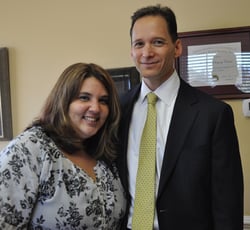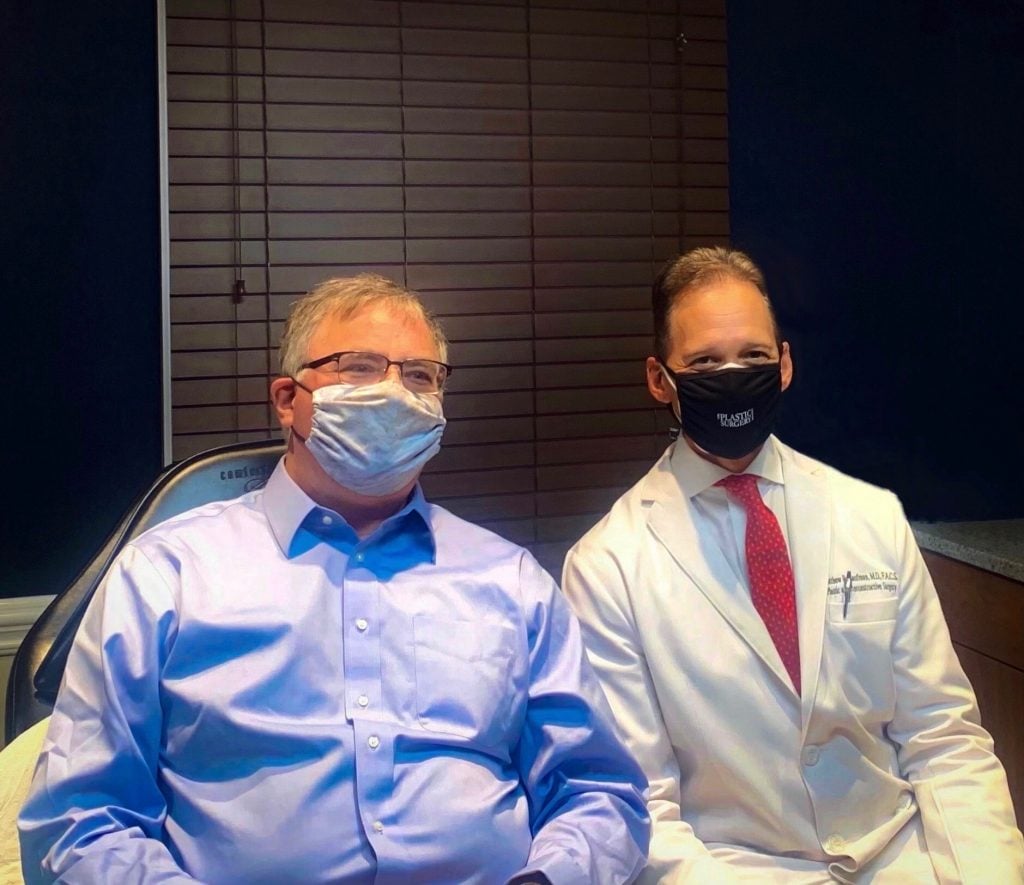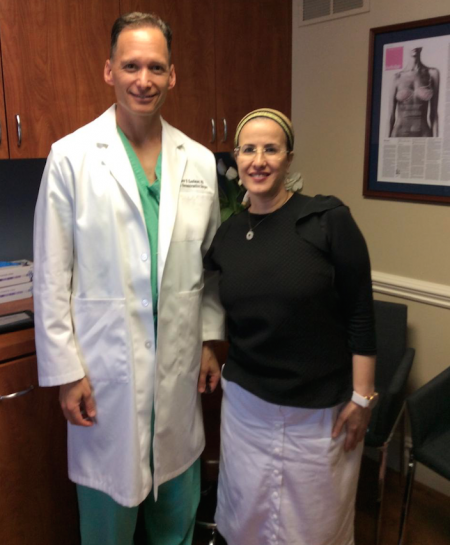Dr. Matthew Kaufman Performs Specialized Phrenic Nerve Surgery on 25-Year-Old Ohio Woman

Phrenic Nerve Patient Heather Stutzman with Dr. Matthew Kaufman of The Institute for Advanced Reconstruction at the Plastic Surgery Center
Dr. Matthew Kaufman of the Institute for Advanced Reconstruction in Shrewsbury, NJ, celebrated his 40th surgery for diaphragm paralysis—this one on his youngest patient to date, 25-year-old Heather Stutzman of Ravenna, Ohio. Kaufman, who is the only known surgeon to perform this surgery, conducted the procedure at the Jersey Shore Medical Center on September 30, 2011.
The phrenic nerve is a large nerve in the chest that controls the diaphragm, which is integral to breathing. Dr. Kaufman either corrects or transplants the nerve in order to restore function, a surgery, which he estimates is successful in 70-80 percent of his patients. While the causes of phrenic nerve injury may vary from accidents to injury during surgery for other conditions, in Stutzman’s case, it appears that radioactive iodine treatment for a thyroid condition likely caused her problem.
When Stutzman arrived for phrenic nerve surgery, she had been in despair. Not only had she been forced to quit the job working with the disabled that she truly loved, but she also faced the continuing risk of pneumonia and other medical problems and suffered the discomfort and embarrassment of wearing a breathing device (oxygen tank). Also, she was so short of breath, she feared she could never have children.
Stutzman, who had been hospitalized with several bouts of pneumonia, was forced for the past year to carry the oxygen tank. As for so many of Dr. Kaufman’s patients, Stutzman’s diagnosis of phrenic nerve damage was a long time coming. Then, she was told by various doctors that there was nothing that could be done for that damaged nerve.
That’s when she went onto the Internet, and like many of his patients, found Dr. Kaufman. “I just wasn’t giving up,” said Stutzman. “I’m too young, and I’ve got my whole life ahead of me.” Her family and friends held a spaghetti fundraiser dinner and raised $7,000 for her expenses.
Following the phrenic nerve surgery, Stutzman woke up and, for the first time, could take a deep breath, without struggling. By the second day, she went shopping in a nearby mall, her oxygen tank now a relic of the past. Denied bowling, dancing, and her other activities, Stutzman will now happily begin a physical rehabilitation program to recondition her damaged diaphragm muscle.
Heather Stutzman’s mother, Michelle, and Heather’s boyfriend of nine years, Sean, accompanied her to New Jersey. The day following her surgery, with tears of joy in her eyes, Stutzman said to Dr. Kaufman, “I think I can be a mom.”
Her message is, “If you’re told there is nothing that can be done, don’t give up. Dr. Kaufman saved my life.”
Dr. Matthew Kaufman is an award-winning cosmetic and reconstructive plastic surgeon, board certified in both Plastic Surgery and Otolaryngology-Head and Neck Surgery, and he is a Fellow of the American College of Surgeons (FACS). Dr. Kaufman embarked on his surgical training at one of the nation’s top training programs for Otolaryngology–Head and Neck Surgery at The Mount Sinai Hospital in Manhattan. He continued his training in Plastic and Reconstructive Surgery at the prestigious UCLA Medical Center in Los Angeles. Among his nerve surgery expertise which he performs together with his partners at the Institute for Advanced Reconstruction in Shrewsbury, NJ, Dr. Kaufman is the only known surgeon to perform specialized phrenic nerve surgery. As of October 2011, Australia will be his furthest patient; 25 is the youngest he has operated on for phrenic nerve problems, and early 70s, the oldest.
Q: How much of your practice is devoted to phrenic nerve surgery?
Approximately forty percent and growing. Each case requires a lot of time. In addition to the actual procedure, there is extensive pre-surgery preparation since most of the patients are from out of town. There’s a tremendous amount of time that goes into preparing each one. To fly across the country, or from someplace else in the world, and have a unique surgery is quite complicated overall.
Q: How common is phrenic nerve injury, and what are its causes?
It’s probably more common than most people think, but hard to know. For example, what percentage of those with this problem is finding us at The Institute for Advanced Reconstruction?
I think there are some standard causes. If you break it down into broad categories, you have a surgical injury (i.e., damage to the nerve while being operated on for other causes), an anesthetic injury (e.g., inadvertent damage by a needle passed into the neck), a manipulation injury (e.g., chiropractic), or some type of trauma (such as a fall from a horse, a car accident, or even a freak twisting the wrong way).
Q: What are the various factors among those requiring this procedure?
Age is a big factor in recovery; young patients regenerate better than older ones. Among our patients, the 25-40-year-olds do much better than the 50-70-year-olds in terms of recovery.
Two-thirds to three-four of the patients are men. Men have more injuries in general—so they undergo more surgery, and chiropractic, and are more likely to get injured from it. Secondly, men are usually bigger and heavier—so if the neck and (big, heavy) arm twist, there is potentially more damage.
Q: How long have you been doing these surgeries, and do you consider 40 a landmark number of procedures?
I think that 40 is a lot for any procedure that’s never been done. I’ve been doing these surgeries since 2007, with the majority of them in the last year and a half. I specialized in phrenic nerve problems by accident. Our website was continually attracting patients with various rare nerve problems. I was challenged to figure out if I could do something for those with phrenic nerve problems requiring surgery.
It falls within my specialties—head and neck, and plastic surgery. The phrenic nerve is not commonly dealt with, unless it is neck or chest surgery, so thoracic or otolaryngology surgeons will encounter the phrenic nerve—but basically just to try to stay away from it. Until now, no one has attempted to actually get to the phrenic nerve—unless they inadvertently harm it– to do something positive with it.
I see the procedures I’ve done are just the tip of the iceberg. I still think the majority of the medical community that takes care of phrenic nerve injury patients has no idea yet, so the goal is to get the word out.
Q: How do you intend to spread the word about your work?
After our recent article in the CHEST Journal* and a well-received seminar in Hawaii**, I hope to expand my “doctor to doctor” outreach so that the medical community can become more familiar and comfortable with our treatment approach. It can be difficult to reach physicians, but now we are getting to know more of them.
Q: How is your success rate with phrenic nerve surgery?
I’ve had a 70-80% percent success rate, which is consistent with other nerve surgeries that have been around for years. No one has 100 percent success. We don’t know enough about the nervous system to be able to achieve that kind of success rate surgically. While we’ve had a remarkable number of positive life-changing results with phrenic nerve cases, we’ve had patients who’ve not gotten better, and those we are waiting on over time, and we don’t know what their ultimate success will be. It can take a long time.
I always want to make procedures better. You always aim for 100 percent success; obviously, no one gets that. That being said, full function (of the phrenic nerve) is the goal I hope for. But if someone gets even 50 percent improvement, his or her life is going to be better.
Over time, I’ve learned a tremendous amount. I have a better understanding of how the nerve functions, and how it gets damaged. So with each case, the success rates are going to get higher.
Q: How do you determine your success rate?
Other than the patient telling you they feel better, there are really only several tests you can do. One would be a study of the nerves, but no one wants to come back and get needles stuck into them for this purpose; another is an x-ray to look for motion in the diaphragm, and the third is breathing tests–pulmonary function tests–which don’t always coordinate with patients’ symptoms. Pulmonary rehab is also an important part of the recuperative process that can help improve outcomes.
Q: How have you been impacted by the psychological or emotional aspect of doing this procedure over time?
I’m more in tune with the emotional aspect, since, previously, I never fully realized the implications of this condition in someone’s life, and quality of life. Most physicians still believe phrenic nerve injury is a relatively minor problem that most people can live with, and that they don’t necessarily need to be treated for it. But my patients have taught me otherwise. That’s what we’re trying to teach the medical community.
Q: What can the patient do to help his/her odds?
If patients have this surgery, they have to exercise the muscle (diaphragm). There are two things that are damaged: the nerve and the muscle. We’re only treating the nerve. I can’t make the muscle better. The muscle has to rebuild itself by exercise, usually through a pulmonary rehabilitation program.
Q: Is every case different both physically and, psychologically?
Yes, each case is different. It’s never cookie-cutter. It’s not like gallbladder surgery. It keeps me on my toes. We always have a standard game plan going into surgery, but I never completely know what I’m going to find until I go in– for example, if a person will need an actual nerve transplant– or what the outcome is going to be. It’s hard to prepare patients; that’s why I tell them all scenarios and proceed with cautious optimism. We also turn away a lot of people. Just last week, I turned a man away. Although he is very symptomatic, he had inconsistent results on the tests we require. His tests show motion in his diaphragm, so I’m not going to take a person with a functioning diaphragm into surgery. I’ve probably turned away as many patients as I’ve operated on.
Q: Do you get ‘performance anxiety’ before doing these surgeries?
I wouldn’t say anxiety, but you get your “game face” on; you get into the zone. You have to plan, think, and prepare. One of my mentors said you have to do three things for surgery: study it, know what you’re going to do; envision the entire process in your head; finally, realize that process.
*Reinnervation of the Paralyzed Diaphragm: Application of Nerve Surgery Techniques Following Unilateral Phrenic Nerve Injury
About the Author: Dr. Matthew Kaufman, MD, FACS
An expert in phrenic nerve surgery, Dr. Matthew Kaufman has performed numerous surgeries to treat diaphragm paralysis and ventilator dependency. Successfully treating over 400 patients across the globe, Dr. Kaufman has been named a Top Plastic Surgeon by New Jersey Monthly magazine and Castle Connolly.






